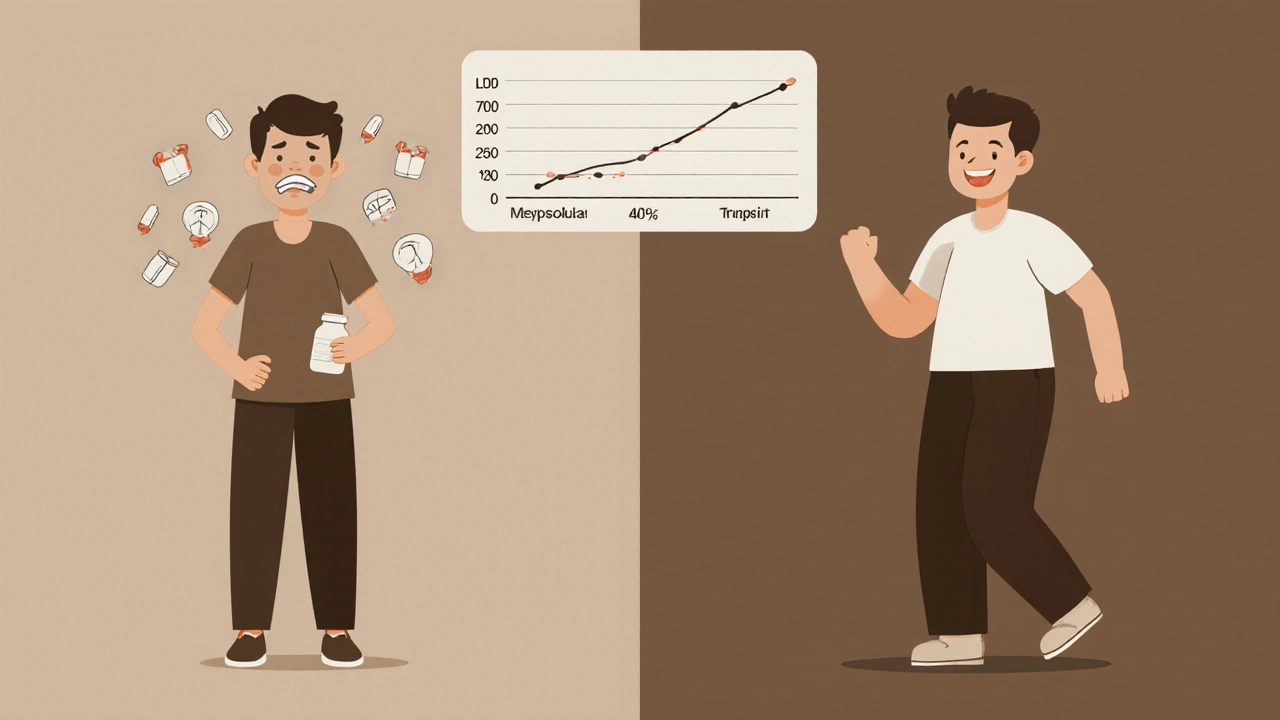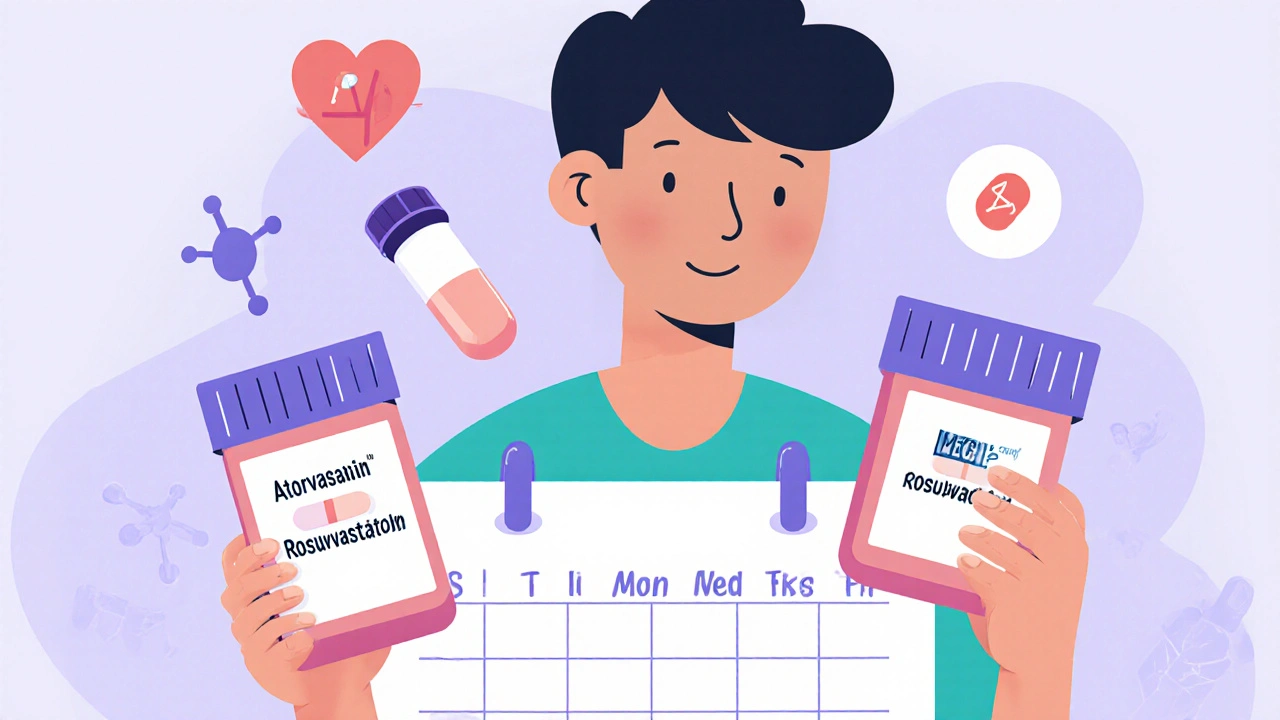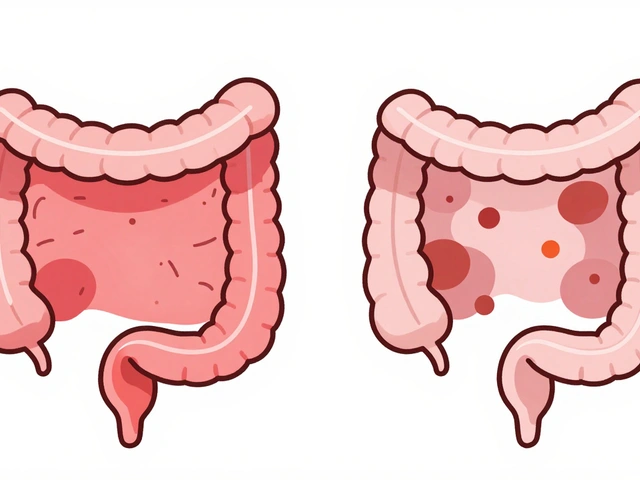Statin Dosing Calculator
Statin Dosing Calculator
Results
LDL Reduction
Estimated LDL Level
Cost Savings
Dosage Recommendation
What if you could cut your statin dose in half-literally-and still keep your LDL cholesterol under control? For many people who can’t tolerate daily statins, this isn’t science fiction. It’s a real, evidence-backed option: alternate-day statin dosing.
Statin intolerance isn’t rare. About 1 in 7 people who take statins report muscle pain, weakness, or cramps so bad they stop taking them. That’s a problem because statins save lives. Lowering LDL cholesterol reduces heart attacks and strokes. But if you can’t stick with daily pills, you’re stuck between a rock and a hard place.
Alternate-day dosing-taking your statin every other day-isn’t FDA-approved. But it’s being used by doctors and patients who’ve run out of options. And the data? It’s surprisingly good.
Why Alternate-Day Dosing Works (And Which Statins It Works For)
Not all statins are the same. Some clear out of your body in a few hours. Others hang around for days. That’s the key.
Atorvastatin and rosuvastatin have long half-lives-14 to 30 hours for atorvastatin, nearly 20 hours for rosuvastatin. That means even if you skip a day, enough of the drug is still in your system to block cholesterol production. Studies show these two work just as well on alternate days as they do daily.
Take the 2012 study by Pramanik and colleagues. They gave 38 people with high cholesterol either 20 mg of atorvastatin daily or every other day. After 12 weeks, both groups lowered LDL by about the same amount: 44% vs. 42%. The difference wasn’t statistically meaningful. Same for total cholesterol.
Same story with rosuvastatin. A 2017 meta-analysis of 11 studies found alternate-day rosuvastatin delivered 92-95% of the LDL-lowering power of daily dosing. That’s not perfect-but it’s close enough to make a real difference in heart risk.
Simvastatin? Not so much. Its half-life is only 1-3 hours. Skip a day, and your cholesterol production rebounds fast. That’s why doctors don’t recommend alternate-day dosing for simvastatin, fluvastatin, or pravastatin.
How Much Do Side Effects Drop?
This is where alternate-day dosing shines.
Statin-associated muscle symptoms (SAMS) are the #1 reason people quit. Pain, stiffness, weakness-sometimes so bad you can’t climb stairs. In clinical trials, 10-15% of patients report these symptoms. In real life, it’s probably higher.
Studies show alternate-day dosing cuts these side effects by 30-50%. One study followed 23 patients who had quit daily statins because of muscle pain. They switched to twice-weekly rosuvastatin or atorvastatin, plus ezetimibe and colesevelam. Result? 87% of them could tolerate it. Zero of them could tolerate daily dosing.
Another study found that patients who switched to every-other-day atorvastatin went from severe muscle pain to being able to walk without discomfort. One patient said, “I haven’t felt this good in years.”
It’s not magic. But it’s a game-changer for people who’ve lost hope.
LDL Reduction: How Much Do You Really Lose?
Alternate-day dosing doesn’t give you the same LDL drop as daily dosing-but it doesn’t drop you into the danger zone either.
On average, you lose about 20-30% of the LDL-lowering effect. So if daily 20 mg of atorvastatin drops your LDL by 50%, every-other-day dosing might drop it by 35-40%.
That’s still enough to meet guidelines for many people. For someone with moderate risk, an LDL of 80 mg/dL is often fine. For someone with a history of heart attack or diabetes, doctors may still want it below 70. In those cases, alternate-day dosing alone might not be enough.
That’s why many doctors combine it with other drugs. Ezetimibe (Zetia) adds another 15-20% LDL drop. PCSK9 inhibitors like Repatha are powerful but expensive-$14,000 a year. Ezetimibe costs $300. Alternate-day statin + ezetimibe often gets you to goal without the price tag.
One study showed 74% of patients tolerated once-weekly rosuvastatin (2.5-20 mg). But only 27% hit their LDL target. Add ezetimibe, and that number jumps. It’s not perfect-but it’s better than nothing.

Cost Savings Are Real
Statin costs are low. Generic atorvastatin 20 mg? About $0.10 to $0.50 per pill. Rosuvastatin 10 mg? Around $0.20 to $1.00.
Take them every other day, and you’re spending roughly half as much. That’s $150-$300 saved per year. Not life-changing money for most-but meaningful for people on fixed incomes or without good insurance.
Compare that to PCSK9 inhibitors: $5,000 to $14,000 a year. Or bempedoic acid (Nexletol): $480 a month. Alternate-day statin + ezetimibe can cost under $500 a year. That’s a 90% cost reduction.
And here’s the kicker: insurance usually covers the drugs, even if they’re not used as labeled. As long as your doctor documents statin intolerance and explains why they’re switching, most insurers will pay.
Who Should Try This?
This isn’t for everyone. It’s for a specific group:
- You’ve tried at least two daily statins and had muscle symptoms
- Your creatine kinase (CK) levels are normal or only mildly elevated (under 10x the upper limit)
- You have high cardiovascular risk (history of heart attack, stroke, diabetes, or very high LDL)
- You’re willing to track your symptoms and LDL levels
If you’re just starting statins, don’t skip to alternate-day dosing. Try lower daily doses first. Maybe switch to a different statin. Maybe add ezetimibe.
Alternate-day dosing is a backup plan. A smart one-but still a backup.
How to Get Started
If you think this might work for you, here’s how to approach it:
- Ask your doctor for a blood test to check your LDL and CK levels before starting.
- Confirm you’re on atorvastatin or rosuvastatin. If you’re on simvastatin or another short-acting statin, switch first.
- Start with the same daily dose, but take it every other day. Example: If you took 20 mg daily, take 20 mg Monday, Wednesday, Friday.
- Wait 4-6 weeks, then get your LDL checked again.
- Track muscle symptoms using a simple scale: 0 = no pain, 1 = mild, 2 = moderate, 3 = severe.
- If LDL is still too high after 8 weeks, your doctor may add ezetimibe.
Use a pill organizer or phone reminder. Skipping doses on purpose feels weird at first. Write it down: “Take pill on Monday, skip Tuesday, take Wednesday,” etc.
What About Long-Term Safety?
This is the big question.
We have good data on short-term LDL lowering and side effects. We have no long-term data on heart attacks or deaths from alternate-day dosing. That’s the gap.
The American College of Cardiology says: “No clinical trial evidence exists for cardiovascular risk reduction with alternate-day dosing.” That’s true. But here’s the flip side: we also have no evidence that people on alternate-day dosing have more heart attacks than those on daily statins.
Most patients who switch are high-risk. Their LDL drops from 180 to 110. That’s still a 40% reduction. That’s enough to lower risk. We just don’t have 10-year follow-up data to prove it.
But we do know this: people who stop statins entirely have higher heart attack rates. Alternate-day dosing keeps them on therapy. That’s likely saving lives.
What Doesn’t Work
Some patients try skipping doses randomly. “I feel fine today, I’ll skip.” That’s a mistake.
Statin effects are cumulative. Skipping unpredictably leads to inconsistent LDL control. Stick to a schedule. Even days. Even if you feel fine.
Also, don’t try this with simvastatin, lovastatin, or fluvastatin. The data doesn’t support it. You’ll waste time and risk your health.
And don’t assume it’s a free pass to eat junk food. Diet and exercise still matter. Alternate-day dosing isn’t a license to ignore lifestyle changes.
Final Thoughts: Is It Worth It?
Alternate-day statin dosing isn’t perfect. But for people who can’t tolerate daily statins, it’s often the only thing that works.
You lose a little LDL-lowering power. But you gain tolerance. You gain quality of life. You save money. You stay on therapy.
And staying on therapy is the whole point.
If you’ve given up on statins because of muscle pain, talk to your doctor. Ask if atorvastatin or rosuvastatin on alternate days could be an option. Bring this info. Ask for a blood test. Give it a real try for 8 weeks.
For millions of people, this isn’t a fringe idea. It’s the difference between heart disease-and a normal life.
Can I take statins every other day instead of daily?
Yes, for certain statins-specifically atorvastatin and rosuvastatin-alternate-day dosing is a proven option for people with statin intolerance. Studies show it reduces LDL cholesterol by 70-80% compared to daily dosing, while cutting muscle side effects by up to 50%. It’s not FDA-approved, but it’s widely used off-label by lipid specialists.
Which statins work for alternate-day dosing?
Only statins with long half-lives work well: atorvastatin and rosuvastatin. These stay active in your body for 14-30 hours, so even every-other-day dosing keeps cholesterol production suppressed. Simvastatin, pravastatin, fluvastatin, and lovastatin have short half-lives and won’t work reliably on alternate days.
Will I still lower my LDL enough to protect my heart?
Most people do. Alternate-day dosing typically reduces LDL by 35-40%, which is enough for moderate-risk patients. High-risk patients (like those with prior heart attacks) may need to add ezetimibe to reach targets below 70 mg/dL. Stopping statins entirely raises heart attack risk more than switching to alternate-day dosing.
Is alternate-day dosing cheaper than daily?
Yes. Since you’re taking half the pills, you cut your medication cost by about 50%. Generic atorvastatin costs as little as $0.10 per pill. Taking it every other day saves $150-$300 a year compared to daily use. That’s far cheaper than PCSK9 inhibitors, which cost over $5,000 annually.
What if I still have muscle pain on alternate-day dosing?
If muscle pain persists, talk to your doctor. You may need to reduce the dose further (e.g., 10 mg every other day) or add ezetimibe to boost LDL lowering without increasing statin dose. In rare cases, switching to bempedoic acid or PCSK9 inhibitors may be needed-but those are more expensive options.
How long should I try alternate-day dosing before deciding if it works?
Give it 6-8 weeks. LDL levels take time to stabilize after a change in dosing. Check your LDL with a blood test at 4-6 weeks. Track muscle symptoms daily using a simple 0-3 scale. If your LDL is down and pain is gone, you’ve likely found a sustainable plan.
Can I stop taking statins completely if I feel better?
No. Statins work by blocking cholesterol production. If you stop, your LDL will rise again within weeks. Even if you feel fine, stopping puts you back at risk for heart attack or stroke. Alternate-day dosing is meant to help you stay on therapy-not stop it.







Adesokan Ayodeji
October 29, 2025 AT 11:01Man, this is the kind of info I wish my doctor had told me three years ago. I was ready to quit statins entirely after the muscle cramps got so bad I couldn’t lift my coffee cup without groaning. Switched to atorvastatin every other day - 20mg on Mon/Wed/Fri - and now I’m hiking on weekends like I’m 25 again. LDL dropped from 182 to 108, and I haven’t felt this good since before my diagnosis. It’s not magic, but it’s the closest thing to a second chance I’ve gotten in this whole heart thing. Seriously, if you’re struggling with side effects, don’t just give up. Talk to your doc about this. You’ve got nothing to lose but the pain.
Also, throw in ezetimibe if you’re still not hitting target. It’s like adding a second engine to a car that’s already running - no extra strain, just more power. And yeah, it’s cheap. Like, stupidly cheap. My monthly cost went from $45 to $12. That’s a coffee and a croissant saved every week.
Don’t let the FDA label scare you. Medicine isn’t a courtroom. It’s a tool. And if this tool lets you live without constant aching, it’s worth it. I’m alive because I didn’t listen to the ‘official’ rules. I listened to my body.
And hey - if you’re reading this and you’re scared to ask your doctor? Just send them this post. I did. They were impressed. That’s how you change the game.
Stay strong. You got this.
Karen Ryan
October 31, 2025 AT 02:38OMG I’m so glad this exists 😭 I’ve been on rosuvastatin daily for 2 years and my legs feel like concrete after walking 10 minutes. Tried this last month - every other day, 10mg - and now I can actually *dance* at my niece’s wedding. No joke. I cried in the bathroom after. My LDL’s at 92 now, not perfect but way better than before I quit. I added ezetimibe and my doc said it’s ‘off-label but clinically sound.’ I feel like a rebel 🥳
Also, I use a pill organizer with colored dots - green for take, red for skip. It’s weird at first but now I forget to skip. Haha. Thanks for sharing this - you just saved my quality of life.
Terry Bell
October 31, 2025 AT 21:13Look, I get why the FDA hasn’t signed off on this - paperwork, lawsuits, liability, all that jazz. But here’s the real question: if you’re alive and moving without pain, does it really matter what the label says?
Medicine used to be about healing people. Now it’s about protecting corporations from lawsuits. I’ve seen too many folks ditch their meds because they couldn’t tolerate them - and then end up in the ER with a heart attack they could’ve avoided.
Alternate-day dosing isn’t ‘alternative medicine.’ It’s just medicine that works better for some bodies. Atorvastatin sticks around. Your liver doesn’t care if you took it yesterday or the day before - it just needs that constant nudge to stop making cholesterol.
And yeah, the cost savings? That’s not a perk. That’s justice. People on fixed incomes shouldn’t have to choose between groceries and heart health.
I’m not saying go wild. Test your CK. Track your LDL. But if you’ve tried everything else and still feel like a zombie? This isn’t a hack. It’s a lifeline. And if your doctor hesitates? Tell them to read the 2017 meta-analysis. I printed it out. Gave it to mine. He nodded and wrote the script.
Live long. Live well. And don’t let bureaucracy steal your mobility.
Lawrence Zawahri
November 2, 2025 AT 13:53THIS IS A PHARMA TRICK. THEY WANT YOU TO THINK YOU’RE ‘SAVING MONEY’ BUT THEY’RE JUST SELLING YOU A HALF-DOSE TO KEEP YOU DEPENDENT. WHY NOT JUST MAKE A 10MG PILLS INSTEAD? WHY THE ‘EVERY OTHER DAY’ GIMMICK? THEY’RE PROFITING OFF CONFUSION. AND DON’T TELL ME ABOUT ‘STUDIES’ - I’VE SEEN THE DATA. THEY USE SMALL SAMPLES AND IGNORE LONG-TERM RISKS.
THEY’RE ALSO PUSHING EZETIMIBE TOGETHER BECAUSE IT’S A BRAND-NAME DRUG THAT COSTS $300 A MONTH - BUT THEY’RE CALLING IT ‘CHEAP’ TO MAKE YOU FEEL SMART FOR TAKING IT.
THIS IS HOW THEY CONTROL YOU. YOU THINK YOU’RE BEING SMART - BUT YOU’RE JUST ANOTHER PATIENT ON THEIR PAYROLL.
WHY NOT JUST EAT LESS SATURATED FAT? WHY NOT EXERCISE? WHY DO YOU NEED CHEMICALS AT ALL? THEY DON’T WANT YOU TO KNOW THE TRUTH.
ASK YOURSELF - WHO BENEFITS FROM YOU TAKING STATINS EVERY OTHER DAY? NOT YOU.
THEY WANT YOU TO BE A PERMANENT CUSTOMER. NOT A HEALTHY PERSON.
Rachelle Baxter
November 3, 2025 AT 22:26Lawrence, your comment is not only factually incorrect but dangerously irresponsible. The pharmacokinetics of atorvastatin and rosuvastatin are well-documented - their half-lives exceed 20 hours, meaning plasma concentrations remain therapeutic for over 48 hours. The 2012 Pramanik study, the 2017 meta-analysis, and multiple real-world cohort studies confirm non-inferiority in LDL reduction and superior tolerability. This isn’t ‘pharma manipulation’ - it’s evidence-based, off-label clinical practice endorsed by lipid societies worldwide.
Furthermore, ezetimibe is generic, inexpensive, and has a 20-year safety record. It doesn’t ‘boost profits’ - it enables patients to avoid costly PCSK9 inhibitors and hospitalizations. Your fearmongering ignores that statin discontinuation increases cardiovascular mortality by 30-50%.
And yes - diet and exercise matter. But for someone with familial hypercholesterolemia or a prior MI, lifestyle alone is insufficient. That’s not ‘chemical dependency’ - it’s medical necessity.
Stop spreading misinformation. People’s lives are at stake. If you don’t understand the science, don’t pretend to. Consult a cardiologist. Or at least read a peer-reviewed journal. Not Reddit conspiracy threads.